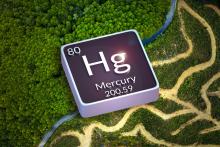About 10 percent of human-made mercury emissions into the atmosphere each year are the result of global deforestation, according to a new MIT study.
The world’s vegetation, from the Amazon rainforest to the savannahs of sub-Saharan Africa, acts as a sink that removes the toxic pollutant from the air. However, if the current rate of deforestation remains unchanged or accelerates, the researchers estimate that net mercury emissions will keep increasing.
“We’ve been overlooking a significant source of mercury, especially in tropical regions,” says Ari Feinberg, a former postdoc in the Institute for Data, Systems, and Society (IDSS) and lead author of the study.
The researchers’ model shows that the Amazon rainforest plays a particularly important role as a mercury sink, contributing about 30 percent of the global land sink. Curbing Amazon deforestation could thus have a substantial impact on reducing mercury pollution.
The team also estimates that global reforestation efforts could increase annual mercury uptake by about 5 percent. While this is significant, the researchers emphasize that reforestation alone should not be a substitute for worldwide pollution control efforts.
“Countries have put a lot of effort into reducing mercury emissions, especially northern industrialized countries, and for very good reason. But 10 percent of the global anthropogenic source is substantial, and there is a potential for that to be even greater in the future. [Addressing these deforestation-related emissions] needs to be part of the solution,” says senior author Noelle Selin, a professor in IDSS and MIT’s Department of Earth, Atmospheric and Planetary Sciences.
Feinberg and Selin are joined on the paper by co-authors Martin Jiskra, a former Swiss National Science Foundation Ambizione Fellow at the University of Basel; Pasquale Borrelli, a professor at Roma Tre University in Italy; and Jagannath Biswakarma, a postdoc at the Swiss Federal Institute of Aquatic Science and Technology. The paper appears today in Environmental Science and Technology.
Modeling mercury
Over the past few decades, scientists have generally focused on studying deforestation as a source of global carbon dioxide emissions. Mercury, a trace element, hasn’t received the same attention, partly because the terrestrial biosphere’s role in the global mercury cycle has only recently been better quantified.
Plant leaves take up mercury from the atmosphere, in a similar way as they take up carbon dioxide. But unlike carbon dioxide, mercury doesn’t play an essential biological function for plants. Mercury largely stays within a leaf until it falls to the forest floor, where the mercury is absorbed by the soil.
Mercury becomes a serious concern for humans if it ends up in water bodies, where it can become methylated by microorganisms. Methylmercury, a potent neurotoxin, can be taken up by fish and bioaccumulated through the food chain. This can lead to risky levels of methylmercury in the fish humans eat.
“In soils, mercury is much more tightly bound than it would be if it were deposited in the ocean. The forests are doing a sort of ecosystem service, in that they are sequestering mercury for longer timescales,” says Feinberg, who is now a postdoc in the Blas Cabrera Institute of Physical Chemistry in Spain.
In this way, forests reduce the amount of toxic methylmercury in oceans.
Many studies of mercury focus on industrial sources, like burning fossil fuels, small-scale gold mining, and metal smelting. A global treaty, the 2013 Minamata Convention, calls on nations to reduce human-made emissions. However, it doesn’t directly consider impacts of deforestation.
The researchers launched their study to fill in that missing piece.
In past work, they had built a model to probe the role vegetation plays in mercury uptake. Using a series of land use change scenarios, they adjusted the model to quantify the role of deforestation.
Link to article:



